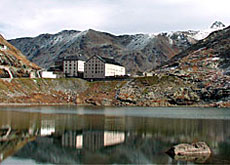Friars offer spiritual welcome at scenic mountain pass

The friars who run the lodgings on the Great St Bernard are ensuring that the long and colourful history of the pass is not forgotten.
“We are still called on to search for people who have lost their way, says Father Frédéric Gaillard, a member of the St Augustine religious order, “even though this rarely happens today.”
“We are here to talk to the people who stop here, people who have lost their spiritual way, so to speak.”
Bernard of Menthon set up a hospice on the pass in the 11th century to care for travellers. His image is everywhere, from a large statue standing guard over the pass to a stained glass window in the hospice church.
Since his time, friars have lived on the pass. But where Gaillard’s predecessors sheltered weary travellers and rescued many who had been lost in storms, or trapped in avalanches, Gaillard and his brethren now keep alive the rich tradition of the pass and hospice, as it is still called, by saving wayward souls.
Romans and Napoleon
The Great St Bernard Pass has been a key route over the Alps since Roman times.
With the rugged peaks above the pass illuminated by the fading autumn light, father Jean-Marie Lovey points to a small lake beside the Roman road. The large number of Roman coins in the water is ample proof of the importance of the pass, he says.
“The soldiers, officers and pilgrims who crossed the pass wanted to appease the gods so they prayed and made offerings to ask to protect them during their journey over the pass,” he says. Often, they gave money, too.
In 1800, Napoleon Bonaparte marched 40,000 troops over its narrow and steep trail.
It was Napoleon, Lovey says, who restored the Roman road, which runs alongside the modern one before breaking off and tracing an old stonewall down into the Aosta Valley.
There is no doubt the friars who ran the hospice at the time greeted Napoleon and his troops.
Perils of the journey
Until the 20th century however, no one would have willingly crossed the pass if they had had another choice, as is evident from vivid accounts retold in the hospice museum.
“It was high morning and everyone was full of fear and trembling. Through holy prayer they were preparing to face menacing death…” wrote a Belgian abbot in 1129 about the state of mind of members of his caravan before they began their ascent.
“…as they were busy accomplishing this duty in the church, terrible news arrived; ten guides who left the village earlier had been swallowed by an enormous mass of snow and had been carried away to the abysses…”
Even though the pass is most often associated with the St Bernard dogs which were once responsible for saving countless lives, the museum is a treasure chest of colourful stories related to the Great St Bernard.
A two metre high copy of the Roman “milestones” which once lined the ancient route stands beside a panel showing the Roman temple dedicated to Jupiter that crowned the pass at the time.
Cold mummified corpses
There’s mention of the “charnel house” where those who never made it over the pass found their final resting place – their corpses mummified by the cold. The building and its inhabitants remain, but its windows and doors were walled up decades ago.
In more recent times, as colourful displays relate, the pass was used for more commercial reasons or in one case, the showboating antics of an American writer who rode an elephant over the pass to re-enact the journey of Hannibal. The poor elephant suffered from altitude sickness.
The pass and its hospice lost importance when a road tunnel was built about 40 years ago. Goods and most tourist traffic between the Swiss town of Martigny and Aosta in Italy have since used the tunnel.
People who choose, nonetheless, to follow the scenic winding road to the top of the pass do so for various reasons.
In summer, many come to see the museum, hike the old Roman road or just admire the collection of cuddly St Bernard dogs — although the animals have long ceased to be used in avalanche rescue missions. A team of archaeologists continues to dig up Roman and Celtic coins, in an effort to learn more about the flourishing trade over the pass in Roman times.
Skiing friars
When the road closes in winter, the friars welcome adventurous groups of cross-country skiers and people on snowshoes. It means that Lovey and Gaillard themselves have to be skilled skiers to get around or to help in avalanche rescue.
“Many people are surprised because they never thought they would find a Christian community up here. They had only heard of the dogs,” says Gaillard. “Suddenly they discover that people have been living up here for nearly a thousand years to receive travellers.”
I think everyone gets something out of a visit,” he continues.
“It’s possible that many aren’t willing to accept that but I believe that nearly all who come up here, particularly in winter, are amazed and do get something in return. It’s difficult to say exactly what but it is something spiritual, even those who claim they are atheists.”
by Dale Bechtel

In compliance with the JTI standards
More: SWI swissinfo.ch certified by the Journalism Trust Initiative

You can find an overview of ongoing debates with our journalists here. Please join us!
If you want to start a conversation about a topic raised in this article or want to report factual errors, email us at english@swissinfo.ch.